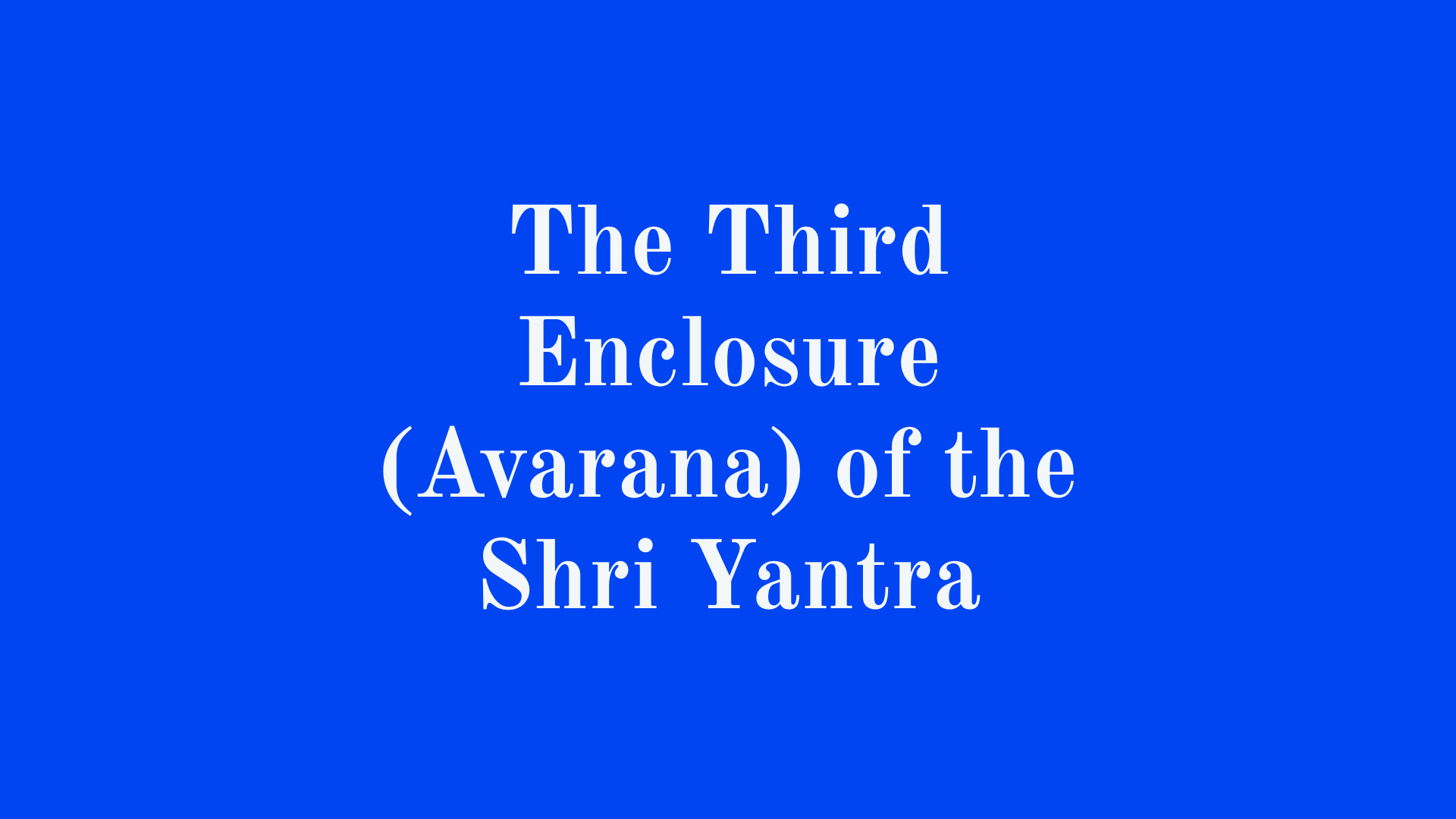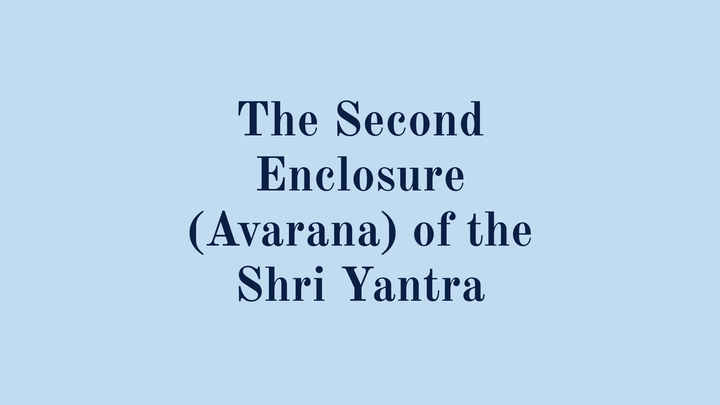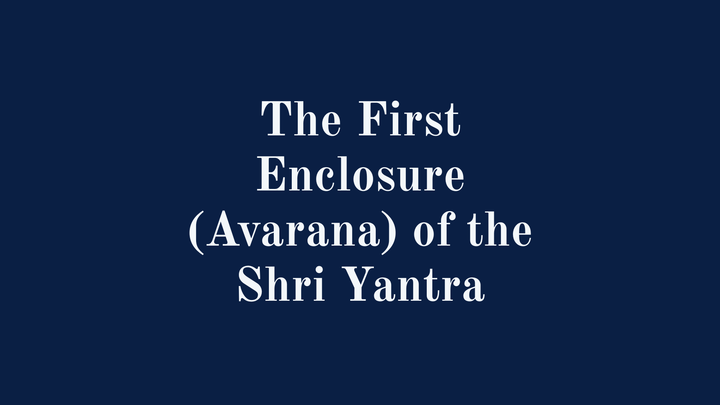The Third Enclosure (Avarana) of the Shri Yantra

We now enter the third āvaraṇa of the Śrī Cakra, known as the Sarva Saṃkṣobhaṇa Cakra. The word saṃkṣobhaṇa means agitation or commotion, and sarva saṃkṣobhaṇa refers to the origin of all forms of mental and existential agitation.
This āvaraṇa represents the stage of subtle psychophysical vibrations—the stirrings of desire, movement, reaction, and response that arise even before they manifest physically. It is an eight-petaled lotus, or aṣṭadala padma (अष्टदल पद्म), located just inside the sixteen-petaled lotus of the second āvaraṇa and outside the fourteen-triangle region of the fourth.
🕊️ Presiding Forces and Yogic Symbols
- Cakreśvarī (Presiding Deity): Tripurasundarī
A subtle and radiant form of the Goddess who remains self-luminous and present through all three states of consciousness—waking, dream, and deep sleep. - Siddhi Devī: Mahimā
Signifying expansive spiritual power. - Mudrā Śakti: Sarvākarṣiṇī
She who attracts and draws in all that exists. - Yoginī Group: Guptatara Yoginīs
These are extremely hidden and subtle manifestations of the Divine Feminine. The prefix gupta-tara (more hidden) reflects the fact that the śaktis in this āvaraṇa are anaṅga, or bodiless—indicating that their operations are mental, vibrational, and supremely refined.
🌸 The Eight Anaṅga Devīs
The petals of this lotus are presided over by eight śaktis, each prefixed with Anaṅga, meaning “bodiless” or “beyond form.” These are all forms of Manmatha (Kāmadeva), the god of love, who is himself known as Anaṅga—pure desire without a form. Each śakti represents a psychophysical impulse or mental modality, and each petal is linked to one group of Sanskrit consonants:
- Anaṅga Kusumā Devī (अनङ्गकुसुमादेवी) – The flower of Eros; linked with speech (vācana) and the 'ka' group of consonants.
- Anaṅga Mekhalā Devī (अनङ्गमेखलादेवी) – The girdle of Eros; related to apprehension (ādāna) and the 'ca' group.
- Anaṅga Madanā Devī (अनङ्गमदनादेवी) – The intoxication of Eros; governing movement (gamana), associated with the 'ṭa' group.
- Anaṅga Madanāturā Devī (अनङ्गमदनातुरादेवी) – The urgency of Eros; symbolizing elimination (visarjana), linked to the 'ta' group.
- Anaṅga Rekhā Devī (अनङ्गरेखादेवी) – The silhouette of Eros; expressing pleasure (ānanda) and linked with the 'pa' group.
- Anaṅga Veginī Devī (अनङ्गवेगिनीदेवी) – The urge of Eros; representing rejection (hāni), connected with the 'ya' group.
- Anaṅga Aṅguśā Devī (अनङ्गअङ्गुशादेवी) – The goad of Eros; standing for attention or approach (upādāna), linked to the 'śa' group.
- Anaṅga Mālinī Devī (अनङ्गमालिनीदेवी) – The garland of Eros; symbolizing detachment (upekṣā), linked to 'la' and 'kṣa'.
Each of these śaktis acts on behalf of Manmatha and creates subtle modifications in the mind. They do not reside in the physical body, but instead influence our inner movements, urges, and psychic experiences. These are the buddhi's eight divisions—ways in which intelligence expresses or distorts itself.
🌀 The Nature of These Śaktis
The first four śaktis (1–4) arise from mūla-jala-tattva (the root water principle) and are mohinī śaktis, meaning they enchant and bind. The next four (5–8) are ākarṣiṇī śaktis, which attract and direct energy.
This symbolism is echoed in the Tantrarāja Tantra, which explains:
Karmendriyārtha doṣāś ca jñeyāḥ syuḥ śaktyoṣṭa vai
"The objects of the five organs of action, combined with the three mental modifications—rejection, acceptance, and indifference—make up the eight śaktis."
Thus, the eight petals signify both external stimuli and internal attitudes: movement, speech, attraction, elimination, attention, withdrawal, and detachment.
🔱 Subtle Philosophy and Symbolism
This āvaraṇa corresponds to the nābhi (navel) region of the body and is connected to the third part of emanation in the Sri Cakra journey. The mantra used for its worship is:
Mantra: Hrīṃ Klīṃ Sauḥ
Color: Pink (pāṇḍura varṇa)
Seed Syllable (Bīja): Haṃ – the bīja of Śiva
Here, Haṃ represents the dissolution (saṃhāra) aspect of Rudra. It is said to symbolize the mahāpralaya (cosmic dissolution) wherein the waking (jāgrat), dreaming (svapna), and deep sleep (suṣupti) states dissolve into undifferentiated awareness.
The ultimate emotion in this āvaraṇa is indifference (upekṣā) — not as negligence, but as transcendence beyond the binaries of pleasure and pain, attraction and aversion. It is perfect equipoise, the foundation of spiritual composure.
🧬 Layers of the Subtle Body
These eight śaktis also signify the eight components of the subtle body (sūkṣma-puryaṣṭaka), namely:
- Prakṛti – Primordial Nature
- Mahattattva – Cosmic Intelligence
- Ahaṃkāra – Ego
- Pañca Tanmātras – Subtle elements
- Pañca Bhūtas – Gross elements
- Daśendriyas – Five jñānendriyas + five karmendriyas
- Antaḥkaraṇa – Inner faculties
- Puruṣa – Witnessing Self
These aspects must be withdrawn (saṃhāra) to approach the center of the Śrī Cakra, just as these śaktis return the emanated world into the One.
🔁 Worship Method (Pūjā Krama)
- Worship begins from the Western petal, unlike the second āvaraṇa which begins from the East.
- The eight Anaṅga Devīs are worshipped in clockwise order, as marked on the petals.
- After them, one worships Mahimā Siddhi, Sarvākarṣiṇī Mudrā, and Guptatara Yoginī.
- As in all āvaraṇas, Yoni Mudrā is offered at the end, and Lalitā Mahātripurasundarī is meditated upon and invoked at every level.
🌺 Spiritual Essence
The Sarva Saṃkṣobhaṇa Cakra marks a turning point in the aspirant’s journey. Here, the mental modalities are acknowledged, honored, and transcended. The aspirant begins to witness their own desires, urges, rejections, and reactions—not as personal flaws, but as vibrations of the one universal śakti.
This āvaraṇa represents both creation and dissolution. When we move away from the center of the Śrī Cakra, we accumulate these qualities and become more deeply veiled in māyā. But when we move inward, we begin to shed them one by one—until only silence, stillness, and Śiva remain.
The third āvaraṇa, the Sarva Saṃkṣobhaṇa Cakra, teaches us that agitation is the outer expression of deeper longing. By recognizing and inwardly offering our movements of mind—speech, desire, urgency, rejection, or indifference—we dissolve them into the presence of Tripurasundarī, who alone shines unshaken through all three states of being.
She, the self-luminous Cakreśvarī of this āvaraṇa, does not reject commotion. She transmutes it. In her presence, we learn that the journey inward is not a battle against the mind, but a loving return of all scattered rays back to the Source.


Comments ()